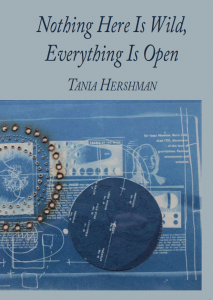 Bristol-based poet, Tania Hershman, is already known for her award-winning short fiction. Nothing Here is Wild Everything Is Open (Southward Editions, 2016) is her debut poetry pamphlet. A second prize winner in the Fool For Poetry Chapbook Contest 2015 and a runner-up in the 2016 Saboteur Awards for Best Poetry Pamphlet, this collection is inspired by science, but, as Hershman points out on her website, ‘no special knowledge is required’ to enjoy the contents. Its front cover features art-work by Eileen White which playfully evokes scientific theory: a taste of what lies within.
Bristol-based poet, Tania Hershman, is already known for her award-winning short fiction. Nothing Here is Wild Everything Is Open (Southward Editions, 2016) is her debut poetry pamphlet. A second prize winner in the Fool For Poetry Chapbook Contest 2015 and a runner-up in the 2016 Saboteur Awards for Best Poetry Pamphlet, this collection is inspired by science, but, as Hershman points out on her website, ‘no special knowledge is required’ to enjoy the contents. Its front cover features art-work by Eileen White which playfully evokes scientific theory: a taste of what lies within.
Hershman, who previously worked as a science journalist, uses her scientific background to highlight – often with a slant wit – the all too creaturely dilemmas that inform many of the twenty two poems. They are vignette-like feats of observation and enquiry. But they always reflect compassion and, at times, a vulnerability that shines through, despite the sense of a patient methodology at work. In ‘The Biologist and the Birds’ the narrator observes the behaviour of birds who fly up against her bedroom window and
‘…..try to get through.
It happens only in daylight
.
though she worries in the night, after
gently burying so many bodies.. ‘
There is a strata in these poems of deep ‘care-taking’ – even if it leads to questioning rather than action. In ‘The Observer Paradox’ the speaker watches a man who comes into a cafe to sell knives, yet who is barely noticed. The poem reflects on its own inability to intervene in appears a repeating cycle of hopelessness:
‘…When he gets home,
boxes intact, will the fact that you
saw him, make any difference
at all? What’s a poem to a person
.
with a room full of boxes
and boxes of unsold
and unwanted knives?
Hershman, analytically alert to pattern, is also clearly vexed by the power of illogic, randomness and perversity to govern behaviour ‘ – ‘science has no answers..’ . A moment that represents continuity from one angle can signal devastation from another. These poems come back again and again to the nature of paradox, particularly in relation to time itself. In one of her darkest but most powerful pieces, ‘Delville Wood,’ she lays out the madness and pity of WW1:
From when they began
to when they ended
it was a moment’s
sigh and droop. It was
.
a cuckoo’s cry.
Fire on them
A horse
Fire on them!
A horse, grazing.
Elsewhere, illogic has a more positive outcome, suggesting that faith, or hope even, have a part to play in mending shattered continuities. The opening poem ‘And What We Know About Time’ depicts the poet’s father mending an alarm clock which then ‘worked/ perfectly’ despite the ‘sixteen horological components/ [he] couldn’t fit back in..’ The same poem also suggests, with a lovely drollness, that on some level ‘dreaming’ – the mind unfettered from rational constraint – helps this process, while at the same time gloriously eluding the necessity to re-establish order. Typical of this writer is an ability to convey her profounder reflections in the most accessible of imagery :’ While the dog/ dreamed and snored, we watched him….attempt reassembly…’
Dreaming as a motif recurs throughout the collection, evoked as a state of openness and possibility. It is contrasted to life lived within natural and social laws. Hershman suggests a constant tug between the two – a pulling apart and a flying back together. Acts of breakage meeting acts of repair. Some poems cry for creative freedom from restraint, as in Nothing Here is Wild where the poet asks us to imagine ‘how far we might get’ if we simply abandoned the need to ‘eat, to drink, love/ ‘ Others explore the hunger for certainty, for some confirming signal. The astronaut of ‘Insomnia’ is in a free floating state ( literally) that induces a vertigo in which she craves ‘some speedoflight transmission a sign’. Gracefully ‘quantum’ in perspective, each poem overtly or implicitly leads us to the brink of some uncertainty, a question, but shies away from closure. The greatest solidity is provided by memory, which acts as a kind of gravity or cement. An iron cooking pot in ‘The Legacy of Chemistry’ is heavy with ‘the remains/ of every meal you made/for me.’
There may be an abstract dimension to Hershman’s themes, but they are related in spare, often entertaining, narratives where there is not one redundant or unserviceable word. She is, above all, a story-teller. Strong detail keeps the reader in the world of tangible sensation, spiced up by the occasional startling image. Formally, the poems echo content, falling into regular patterns in one mode, only to be tugged apart, elsewhere, by open field layouts or stepped phrasing. Condensed prose poems visually counterpoint the more experimental pieces. There is evidence here of a skilful operator. But the skill is purposeful and resonant in effect. While always engaging and lightly handled, these are profound, many levelled poems that ask to be re-read – and re-read again.










